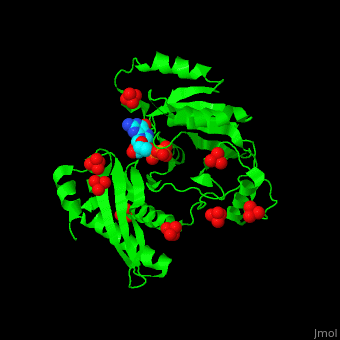GTP-binding protein
From Proteopedia
FunctionGTP-binding proteins or G proteins are transmitting signals outside the cell which cause changes within the cell. They act as molecular switches which are on when binding GTP and off when binding GDP. GTP-binding proteins belong to two families: heterotrimeric G proteins[1] see Transducin and small GTPases[2].
G protein-coupled receptor DiseaseMutations in heterotrimeric G protein α subunit were identified in endocrine tumors and in McCune-Albright syndrome[4]. RelevanceRho-related small GTP-binding protein is inhibited by the antifungal drug Cancidas[5]. Structural highlightsE. coli small GTPase ERA binds GDP in a cavity formed by 7 highly conserved regions G1, G4, G5[6]. GDP binding site. Water molecules are shown as red spheres. 3D Structures of GTP-binding proteinGTP-binding protein 3D structures
|
| |||||||||||
See Also
References
- ↑ Preininger AM, Hamm HE. G protein signaling: insights from new structures. Sci STKE. 2004 Jan 27;2004(218):re3. PMID:14762218 doi:http://dx.doi.org/10.1126/stke.2182004re3
- ↑ Takai Y, Sasaki T, Matozaki T. Small GTP-binding proteins. Physiol Rev. 2001 Jan;81(1):153-208. PMID:11152757
- ↑ Kim YI, Bandyopadhyay J, Cho I, Lee J, Park DH, Cho JH. Nucleolar GTPase NOG-1 regulates development, fat storage, and longevity through insulin/IGF signaling in C. elegans. Mol Cells. 2014 Jan;37(1):51-7. PMID:24552710 doi:10.14348/molcells.2014.2251
- ↑ Lania A, Mantovani G, Spada A. G protein mutations in endocrine diseases. Eur J Endocrinol. 2001 Nov;145(5):543-59. PMID:11720871
- ↑ Moreno-Velasquez SD, Seidel C, Juvvadi PR, Steinbach WJ, Read ND. Caspofungin-Mediated Growth Inhibition and Paradoxical Growth in Aspergillus fumigatus Involve Fungicidal Hyphal Tip Lysis Coupled with Regenerative Intrahyphal Growth and Dynamic Changes in beta-1,3-Glucan Synthase Localization. Antimicrob Agents Chemother. 2017 Sep 22;61(10). pii: AAC.00710-17. doi:, 10.1128/AAC.00710-17. Print 2017 Oct. PMID:28760907 doi:http://dx.doi.org/10.1128/AAC.00710-17
- ↑ Tu C, Zhou X, Tropea JE, Austin BP, Waugh DS, Court DL, Ji X. Structure of ERA in complex with the 3' end of 16S rRNA: implications for ribosome biogenesis. Proc Natl Acad Sci U S A. 2009 Sep 1;106(35):14843-8. Epub 2009 Aug 17. PMID:19706445
Proteopedia Page Contributors and Editors (what is this?)
Michal Harel, Alexander Berchansky, Joel L. Sussman, Wayne Decatur, Jaime Prilusky

